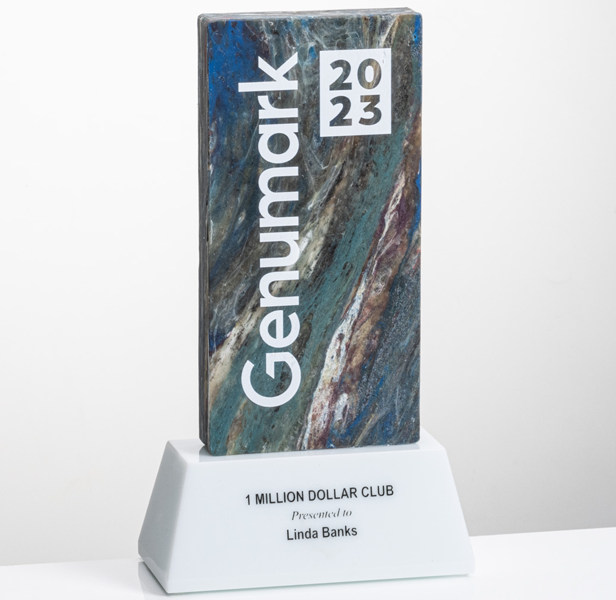Counselor Top 40 distributor Genumark (asi/204588) wanted to do something different for its annual internal sales awards.
“In our industry, once you’ve been giving awards out for years and years, they all look fairly similar,” says Marc Newberry, creative director at Genumark. “We wanted to make these a little more unique.”
Plus, he adds, as a certified B Corp, “We’re always trying to think of better ways of doing the things we do.”

That’s where St Regis Group (asi/84592; Canada, asi/84595) came in. The supplier has been developing new sustainable PlastEco awards – made from plastic bags and waste sourced from supermarkets and other businesses. Once Genumark caught wind of the idea, the distributor reached out to St Regis and asked to be a guinea pig on the project.
“I just kind of rammed this project through because I was so excited about it,” says Brianna Mazze, vice president of compliance and sustainability at St Regis.
St Regis works with a Vancouver-based artist who creates massive art installations in universities and hospitals using recycled plastics – as a way to raise awareness about the plastic waste crisis. The PlastEco awards, which have a marbled effect, are made primarily from low-density polyethylene and high-density polyethylene soft plastic waste. Think discarded grocery bags and other thin plastic waste.
“There’s really not much you can do with thin plastic waste,” Mazze says. “It doesn’t have a really good application for making anything out of it. But with this application – talking about the plastic crisis and giving it a new life other than just going into a landfill – it’s just so valuable, and that’s what gives it such a unique, interesting, authentic story.”
Key Plastic Waste Facts
• Plastic waste makes up 80% of all marine pollution.
• Eight million to 10 million metric tons of plastic end up in the ocean each year.
• There are about 50 trillion to 75 trillion pieces of plastic and microplastics in the ocean currently.
Source: UNESCO Ocean Literacy Portal.
To create a PlastEco award, the artist collects waste from neighborhood sources and then sorts it by color and other factors in the studio. The sorted soft plastic is then melted and transformed into three-quarter-inch plates – a stage that requires precision and expertise to achieve the unique marbled look. In the finishing phase, the recycled plastic plates are milled into the final product, before being sanded, planed and buffed. Additional coatings may be applied to enhance the durability and aesthetics of the awards, and an imprint can be added with a digital printer.

Each award integrates approximately 60 shopping bags’ worth of plastic waste. The awards also incorporate recycled pellets derived from fishing nets gathered along the shoreline of British Columbia by Ocean Legacy, an organization St Regis has partnered with that’s devoted to solving the plastic waste problem. Ocean Legacy has diverted more than 1.5 million pounds of plastic from landfills and collected more than 2.9 pounds of plastic from cleanups, according to its website.
PlastEco awards, Mazze says, are “elevated trash.”
But they were anything but garbage to the sales team at Genumark. “They were kind of amazed that they weren’t marble initially,” Newberry says, adding that once they realized they were made of recycled plastic, “they were interested in learning how they were made and selling them to their own clients as well.”
The project with Genumark was the first time St Regis has worked with the PlastEco awards, and the supplier is tinkering with new designs to get the product into stock.
The challenge, Mazze says, is that it’s such a “custom medium,” and requires a lead time of anywhere from six to 12 weeks, since for each project, the artist “has to literally go out and find the recycled contents.” The hands-on artistic process is also “wildly expensive” because each recycled plastic sheet is individually crafted. St Regis is working with the artist on ways to scale the material and also experimenting with designs that feature the marbled recycled plastic, but aren’t made 100% from it, for a more cost-effective option, Mazze says.
“It has such a beauty to it that a lot of recycled materials don’t have when they’re made into pellets or fabrics,” Mazze says. “This is more like an upcycled material that’s handmade and custom.”



